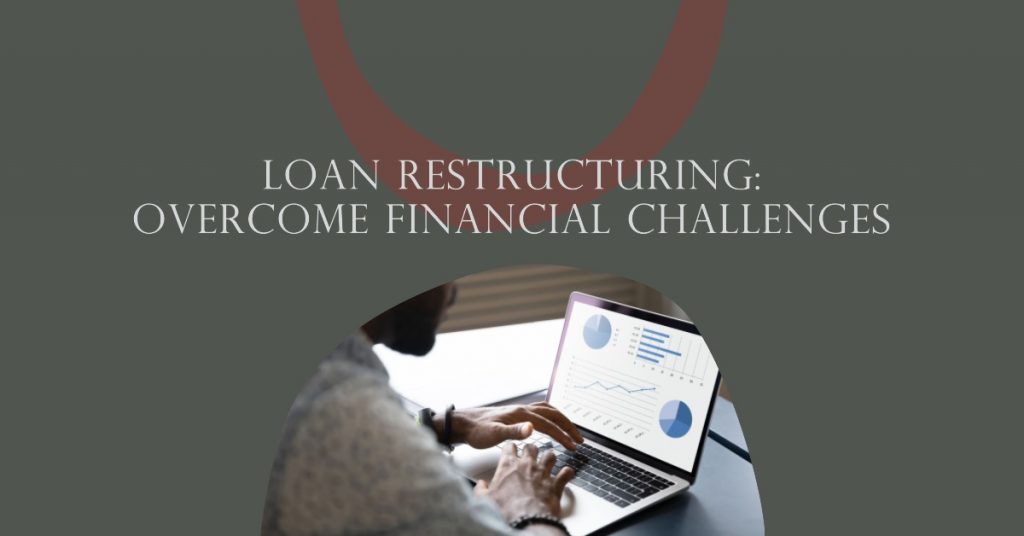
Are you struggling to keep up with your loan payments? You’re not alone. With the current economic climate, it can be difficult for many of us to make ends meet. But there is a way to help you get back on track: loan restructuring. Restructuring your loans can provide much-needed relief from financial pressure and help you find a better balance between income and expenses. So let’s explore how this strategy can assist you in overcoming financial challenges—from lowering monthly payments to avoiding default and foreclosure—and protect your creditworthiness in the long term. By understanding exactly what loan restructuring is and how it works, we can learn how to make use of this powerful tool for our own benefit.
Lower Monthly Payments
You could be able to lower your monthly payments and gain some financial relief with loan restructuring. Restructuring is a process that allows you to change the terms of your loan agreement, such as extending the repayment period or lowering the interest rate. This can have an immediate effect on how much you are paying each month, allowing you to pay less and better manage your budget.
In addition, if you qualify for loan forgiveness programs, then certain loans may be completely wiped away or portions of them forgiven which will also help to reduce your debt load. Finally, it can give you more time to pay off what is owed without incurring late fees or high-interest charges which could further strain your finances.
Restructuring can be a great way to manage debt while working towards getting out of a difficult financial situation. It provides some breathing room and peace of mind knowing that there are options available when struggling financially.
Debt Consolidation
Feeling overwhelmed by debt can be an incredibly stressful experience. One way to find relief is through debt consolidation, which combines all of your loans into one single loan with a lower interest rate and longer repayment period. This can help you reduce the amount of money you owe each month, creating more manageable payments and freeing up more money for other financial needs. Debt consolidation also allows you to keep track of all your debts in one place, making it easier to stay organized and on top of payments.
When considering debt consolidation, it’s important to understand how different types of loans may affect your credit score. Some loans may have higher rates or could require collateral, so doing research ahead of time can save time and money in the long run. It’s also wise to look at fees associated with consolidating debt, as some lenders may charge additional costs that could make refinancing less attractive than anticipated.
Debt consolidation isn’t right for everyone – if you’re already struggling with budgeting or think you may need additional support managing your finances, it might not be the best option for you right now. However, when done correctly under the guidance of a financial advisor or planner who understands your particular situation and goals, it can be an effective tool for reducing monthly payments while staying on track towards eliminating debt entirely.
Improved Cash Flow
Consolidating your debt can improve cash flow, allowing you to free up more of your income each month. By combining multiple debts into one, you reduce the number of payments and interest rates you have to keep track of. This makes it easier to plan and budget for future expenses, and also helps you determine how much money is available for discretionary spending without having to worry about high interest payments on existing debts. Additionally, loan restructuring can help reduce the total amount owed by extending the repayment period or reducing interest rates. This allows borrowers to save money on their monthly payments while still meeting their obligations.
Another way loan restructuring can help increase cash flow is by allowing borrowers to make smaller periodic payments over a longer period of time. For example, instead of making a large payment every month for a set amount of time that may be difficult to manage financially, borrowers could opt for smaller payments spread out over an extended repayment period such as two years or more. This type of arrangement gives borrowers more flexibility in managing their budget and allows them to use any extra money from each paycheck towards savings or other financial goals rather than worrying about debt repayments.
Loan restructuring provides several benefits that can help people overcome financial challenges in terms of improved cash flow management. Not only does this allow individuals to reduce their monthly payments in order to free up more disposable income each month but it also reduces overall costs associated with debt consolidation by reducing interest rates or extending the repayment period. Loan restructuring is an effective way for borrowers to take control of their finances and move forward with greater financial security.
Avoiding Default and Foreclosure
Defaulting on a loan or facing foreclosure can be an overwhelming situation, but loan restructuring can provide the guidance and support needed to avoid these issues. Loan restructuring is a process of renegotiating the terms of an existing loan agreement so that it better suits the borrower’s current financial situation. This could include extending the length of repayment, lowering interest rates, reducing monthly payments, or combining multiple loans into one payment. Restructuring also allows borrowers to more easily prioritize their financial obligations by creating a manageable repayment plan.
Borrowers who are struggling with their finances should consider working with a financial advisor who specializes in loan restructuring to help them understand their options and create a tailored repayment plan that works for their specific circumstances. The advisor will review all loan documents and assess each borrower’s credit history as well as any other relevant information before making recommendations for how best to restructure the loan.
By taking proactive steps such as restructuring loans, borrowers increase their chances of avoiding default and foreclosure while ensuring they have enough money for more pressing expenses such as rent or food costs. With careful planning, borrowers can make sure they are better able to manage their debt while improving their credit score over time.
Negotiating with Creditors
Negotiating with creditors can be a daunting task, but taking the time to understand your financial situation and develop a plan of action can provide some relief. Before attempting to negotiate with creditors, you should review your budget and identify what you can afford to pay each month. Additionally, it is important to organize all relevant documents such as credit reports and loan agreements. Make sure that you have an understanding of the terms of the loan as well as the amount owed and due dates before engaging in any negotiation process.
Once you are organized and prepared for negotiations, it is important to first contact your creditor by telephone or email and explain why you are unable to make payments on time. It is best practice to remain professional when communicating with creditors so that they take your request seriously; be honest about your current financial situation without making any threats or promises that may not be kept. When negotiating, it is important to keep in mind that creditors would rather receive partial payments than nothing at all; therefore, suggesting a lower payment amount than originally agreed upon could be beneficial for both parties involved.
When negotiating loan restructuring terms with a creditor, make sure that you get everything in writing including all changes made such as different interest rates or reduced balances due upon agreement approval. This will help protect yourself from future disputes if anything goes wrong during the repayment process. Furthermore, ensure that the new agreement includes clear information regarding payment methods accepted and late fees imposed if applicable; this way both parties will feel secure knowing exactly what is expected from them throughout the entire repayment period.
Preserving Creditworthiness
Taking steps to preserve your creditworthiness is key in helping you stay afloat amid financial difficulties. By maintaining a healthy credit score, loan restructuring can be used as a tool to help you manage debt and regain control of your finances. Establishing an agreement with creditors that allows for lower payments or extended repayment terms are two examples of how loan restructuring can benefit both parties involved. Furthermore, it’s important to continue making timely payments even if the agreement states otherwise; this shows lenders that you are taking ownership of their money and will ultimately improve your credit score over time.
In order to successfully restructure loans, it is important to have a clear understanding of what debts need to be paid off first, which ones can wait and how much can realistically be paid back each month. Additionally, having accurate records of all expenses will help create a viable plan for negotiating with creditors that meets everyone’s needs. Not only does this show them that you are organized and reliable but also demonstrates that you take full responsibility for your actions.
Loan restructuring provides an opportunity for individuals facing financial challenges to get back on their feet while still being able to pay off their debts in the long run. It is important, however, to follow through on commitments made during negotiations and remain proactive when addressing any changes in financial circumstances; doing so will ensure successful outcomes for all parties involved as well as keep one’s credit score from plummeting further down the line.
Long-Term Financial Planning
Making a long-term financial plan is essential to ensuring your financial success and stability in the future. It involves taking a look at your current finances, setting goals for what you want to achieve in the coming months and years, and then creating a strategy to reach those objectives. A long-term financial plan should include allocating funds for savings, investments, and other expenses such as mortgage payments or loan repayments. It’s also important to consider how any changes in income or expenses may affect your ability to meet these goals over the course of time.
Creating a long-term financial plan can be especially helpful when it comes to loan restructuring. By understanding your budget and setting realistic expectations for yourself, you can better assess whether loan restructuring is right for you. This includes considering whether you have enough money left over after paying back loans each month to cover living costs or if additional debt reduction could help relieve some of the strain on your finances. Furthermore, knowing what type of loan products are available can make it easier to choose one that best suits your needs and budget over time.
When it comes to managing debt more effectively, having an effective long-term financial plan is key. Doing so helps ensure that you are able to keep up with payments while still allowing room for other priorities such as building up savings or investing in retirement accounts. Additionally, having this kind of roadmap can provide peace of mind by showing how much progress has been made towards achieving desired goals throughout the process – making it easier than ever before to overcome financial challenges through loan restructuring.
Conclusion
You’ve seen how loan restructuring can help you overcome some of your financial challenges. By lowering your monthly payments, consolidating debt, and improving cash flow, you can avoid defaulting on loans or facing foreclosure. You’ll also be able to preserve your creditworthiness and create a plan for long-term financial success. But don’t forget: loan restructuring isn’t a magic solution! It requires effort and dedication on your part to make sure that it works for you in the long run. With commitment and care, however, you can turn a difficult situation into an opportunity for lasting financial health.








